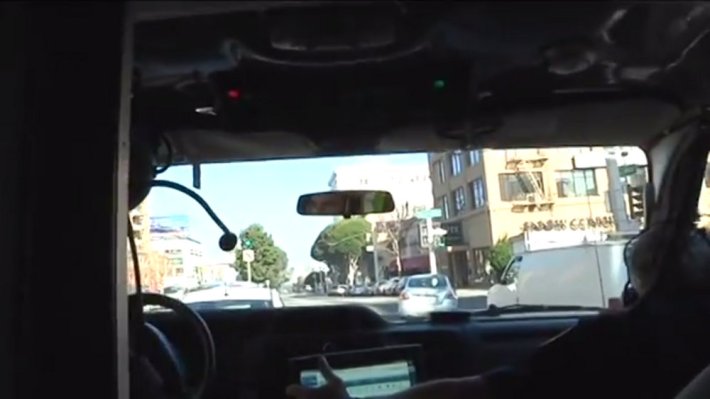SFFD Not Sure What Delays Responses: “There Might Just Be More Cars”
4:56 PM PST on January 21, 2014

An official from the SF Fire Department explained SFFD's position on bulb-outs and road diets last week to the SF Pedestrian Safety Advisory Committee. According to Assistant Deputy Chief Ken Lombardi, the department's main concern isn't about curb extensions, but raised "hardscape" structures like planters or railings that can prevent a fire truck from mounting them.
Although SFFD hasn't publicly called for increased police enforcement against drivers who double park -- a major impediment to fire trucks and ambulances -- Lombardi said he agrees that enforcement should be stricter, but that double parking is "a reality."
"We're dealing with it every day, where if there's a delivery truck, there's a construction job going on, there's a double-parked car," Lombardi said. "If it's a 20-foot street, we can easily go around that, but if all of the sudden it's a 14- or 16-foot wide street, that becomes an issue."
Lombardi stressed that SFFD is "not dead-set against bulb-outs," and that the department approves them on a routine basis. "But when it creates a situation where we can't legally make a turn, it's hard for us to just say okay," he said. "There's no doubt it'll make it safer for pedestrians, I'm just saying for our fire operations, it makes it tougher." Lombardi also denied a recent report from SFMTA Director Ed Reiskin that SFFD officials said they were worried about getting tickets from police when entering an oncoming lane to make a wide turn.
According to data presented by Lombardi, response times for stations in the Mission and the Castro have increased an average of 19 seconds in the past four years, compared to 10 seconds citywide. While Lombardi noted that "a lot of traffic calming measures have been put in place in the past two years" in those neighborhoods, SFFD says it doesn't have a way to determine what's causing response delays.
"We have other things to think about" when responding to an emergency, said Fire Marshall Michie Wong.
PSAC member Gary McCoy suggested the flood of recent development and construction in those neighborhoods may be a major factor. In response, Lombardi said, "I don't know if it's a traffic calming measure or not, there might just be more cars there."
Morgan Fitzgibbons, another PSAC member, said he'd like to see SFFD make "a good-faith effort" to collect data on sources of delay. Without a firm grasp of those factors, hearing SFFD blame life-saving traffic calming measures, he said, is "tough to stomach as a pedestrian advocate."
"We know why we want these improvements," he said.
SFFD has been known to water down measures to install bulb-outs and narrow roadways, including a recent set of corner sidewalk extensions on local streets around E.R. Taylor Elementary, where the department sought to shrink curbs by a foot, though the SFMTA dismissed SFFD's protests. SFFD also fought a plan to narrow the road on a dead-end block of Bartlett Street to 14 feet, claiming fire trucks need the 20-foot minimum recommended by state standards, although many cities use 12-foot minimums without problems.
Other projects, including plans for raised, protected bike lanes with mountable curbs on Second Street and Masonic Avenue, have also drawn the department's opposition, according to the SF Examiner. In December, SFFD Fire Chief Johanne Hayes-White wrongly blamed 74 percent of pedestrian injuries on the victims, and SFFD issued a statement denying "allegations from special interest groups" that the department opposed safety measures.
Lombardi did note that traffic calming projects like the road diet redesign of Valencia Street, which included a center left-turn lane for both directions of traffic, can actually make it easier for emergency responders to pass traffic.
Responding to the suggestion that SFFD use smaller vehicles for narrower streets, such as those in use by a station in Bernal Heights and commonly seen in Europe and Japan, Lombardi said it's difficult to purchase them in the U.S. since they tend not to meet smog standards. He also said powerful engines are needed to climb San Francisco's steep hills, limiting the types of fire trucks they can buy.
While we may not have data showing private autos as a primary source of delay, KRON 4's Stanley Roberts continues to provide video reporting showing the problem. Following up on his December "People Behaving Badly" segment showing drivers regularly blocking a fire station exit in SoMa, Roberts' latest piece features a ride-along in an ambulance, finding that many drivers routinely fail to pull to the side of the street to make way for siren-blaring vehicles:
Read More:
Stay in touch
Sign up for our free newsletter
More from Streetsblog San Francisco
Independent Safety Advocates Beef up the Wiggle
Signs and soft-hit posts installed by advocates make the Wiggle bike route calmer and safer for cyclists and pedestrians




